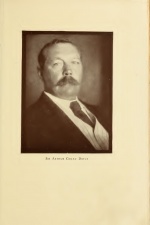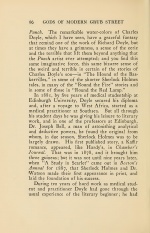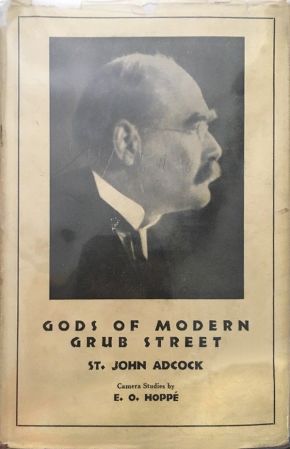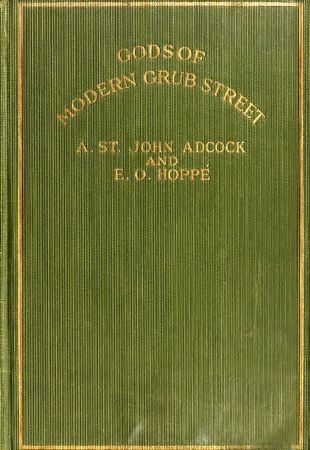Gods of Modern Grub Street: Difference between revisions
No edit summary |
(No difference)
|
Latest revision as of 00:42, 20 March 2019








Gods of Modern Grub Street: Impressions of Contemporary Authors is a book written by Arthur St. John Adcock published by Sampson Low, Marston & Co. (London) and Frederick A. Stokes Co. (New York) in 1923. 32 photos by Emil Otto Hoppé.
The book includes 32 articles about the following authors : Thomas Hardy, Hilaire Belloc, Arnold Bennett, John Davys Beresford, John Buchan, Donn Byrne, William Henry Davies, Walter de la Mare, Sir Arthur Conan Doyle, John Drinkwater, Jeffery Farnol, John Galsworthy, Sir Anthony Hope Hawkins, Arthur Stuart Menteth Hutchinson, Sheila Kaye-Smith, Rudyard Kipling, William John Locke, Stephen McKenna, Compton Mackenzie, John Masefield, Alfred Edward Woodley Mason, William Somerset Maugham, William Babington Maxwell, Leonard Merrick, Alan Alexander Milne, Alfred Noyes, E. Phillips Oppenheim, May Sinclair, Frank Swinnerton, Hugh Walpole, Herbert George Wells, Israel Zangwill.
Below is only displayed the article about Arthur Conan Doyle.
Editions
- Gods of Modern Grub Street (1923, Sampson Low, Marston & Co. [UK])
- Gods of Modern Grub Street (1923, Frederick A. Stokes Co. [US])
Covers
-
Sampson Low, Marston & Co. (1923, dustjacket)
-
Frederick A. Stokes Co. (1923, cover)
Sir Arthur Conan Doyle
If Sir Arthur Conan Doyle were more of a conventional man of letters — had he been just "a book in breeches," as Sidney Smith said Macaulay was — it would not be so difficult to know where to make a beginning when one sits down to write of him. But no author could be farther from being "all author"; he is much too keenly interested in life to do nothing but write about it, and probably shares Byron's scorn of "the mighty stir made about scribbling and scribes," and his preference of doers to writers. He has read much, but lived more, as a novelist ought to, giving freely of Isis time and thought and sympathy to lives outside his own. He has no fretful little moods of morbidity, cynicism, pessimism, but is essentially a big man and writes always like himself, with a complete freedom from affection, a naturalness, a healthy vigor and breadth of outlook that cannot be developed within the four walls of a study.
Characteristic of himself, I think, is this reflection in "The Tragedy of the Korosko": "When you see the evil of cruelty which nature wears, try and peer through it, and you will sometimes catch a glimpse of a very homely, kindly face behind." And this, whirls he puts into the mouth of Lord Roxton; in "The Lost World"; "There are times, young fellah, when every one of us must make a stand for human right and justice, or you never feel clean again."
You may depend he felt that time had come for him when he took up the cudgel for George Edalji and would not rest or be silent till the case had been reopened and Edalji proved innocent and set at liberty; it came again when he threw everything else aside to render patriotic services in the Boer War (which were to some extent recognized by the accolade), and again in the later and greater War; it came for him when he resolutely championed the cause of the martyred natives in the Belgian Congo; when, believing in Oscar Slater's innocence, he wrote a masterly review of the evidence against him and strove to have him retried; and it came once more when, risking his reputation and in defiance of the ridicule he knew he would have to face, he openly confessed himself a believer in spiritualism and has persisted in that unorthodoxy until he has become one of the most powerful and insistent of its apostles.
These and other such activities may seem outside a consideration of Doyle's work in literature, but they are not, any more than are his medical knowledge or his love of sport, for you find their influence everywhere in his books. There were ghosts in his fiction before ever he began to raise them at the seance. Some find it hard to square his absorption in spiritualism with his robust personality, with the sane philosophy of his stories, and the fact that he is so much a man of action, a lover of the open air and all the wholesome human qualities that keep a writer's blood sound and prevent his ink from getting muddy and slow. But it is just these circumstances that add weight to his testimony as a spiritualist; he is no dreamer predisposed to believe in psychic phenomena; he is a stolid, shrewd man of affairs who wants to look inside and see how the wheels go round before he can have faith in anything.
He has played as strenuously as he has worked. He has tasted delight of battle with his peers at football, cricket, golf ; he has made balloon and aeroplane ascents; introduced skiing into the Grison division of Switzerland; did pioneer work in the opening up of miniature rifle ranges; can hold his own with the foils and is a formidable boxer; he is a fisherman in the largest sense, for he has been whaling in the Arctic Seas, he used to ride to hounds and is a good shot, but has a hearty hatred of all sport that involves the needless killing of birds or animals.
Born at Edinburgh, in 1859, Conan Doyle commenced writing tales of adventure when he was about six, and it was natural that he should illustrate these with drawings of his own, for he was born into a very atmosphere and world of art. His grandfather, John Doyle, was the well-known political caricaturist who for over thirty years concealed his identity under the initials "H. B."; his father, Charles Doyle, and three of his uncles were artists, one being that Richard Doyle whose name is inseparably associated with the early days of Punch. The remarkable water-colors of Charles Doyle, which I have seen, have a graceful fantasy that remind one of the work of Richard Doyle, but at times they have a grimness, a sense of the eerie and the terrible that lift them beyond anything that the Punch artist ever attempted; and you find this same imaginative force, this same bizarre sense of the weird and terrible in certain of the stories of Charles Doyle's son — in "The Hound of the Baskervilles," in some of the shorter Sherlock Holmes tales, in many of the "Round the Fire" stories and in some of those in "Round the Red Lamp."
In 1881, by five years of medical studentship at Edinburgh University, Doyle secured his diploma and, after a voyage to West Africa, started as a medical practitioner at Southsea. But all through his student days he was giving his leisure to literary work, and in one of the professors at Edinburgh, Dr. Joseph Bell, a man of astonishing analytical and deductive powers, he found the original from whom, in due season, Sherlock Holmes was to be largely drawn. His first published story, a Kaffir romance, appeared, like Hardy's, in Chamber's Journal. That was in 1878, and it brought him three guineas; but it was not until nine years later, when "A Study in Scarlet" came out in Beeton's Annual for 1887, that Sherlock Holmes and Dr. Watson made their first appearance in print, and laid the foundation of his success.
During ten years of hard work as medical student and practitioner Doyle had gone through the usual experience of the literary beginner; he had suffered innumerable rejections, had contributed short stories to Cornhill, Temple Bar, Belgravia and other magazines, never in any year earning with his pen more than fifty pounds. His first long novel, that brilliant romance of the Monmouth rebellion, "Micah Clarke," after being rejected on all hands, was sent to Longmans and accepted for them by Andrew Lang, whom Sir Arthur looks upon as one of his literary godfathers, James Payn, who encouraged him in Cornhill being the other.
"Micah Clarke" was followed in the same year (1889) by another Sherlock Holmes story, "The Sign of Four." In 1890 Chatto & Windus published "The Firm of Girdlestone," and "The White Company" began to run serially in Cornhill. Then it was that, taking his courage in both hands, Sir Arthur resigned his practice at Southsea and came to London. He practised there for a while as an eye specialist, but the success of those two last books decided him to abandon medicine and devote himself wholly to literature.
He has written a score or so of novels and volumes of short stories since then; one — and an admirable one — of literary criticism, "The Magic Door"; two of verse; a History of the Boer War, and three or four volumes embodying his gospel and experiences as a spiritualist. This is to say nothing of his plays — "A Story of Waterloo," the Sherlock Holmes dramas, and the rest.
"Sir Nigel" and "The White Company" are, in his own opinion, "the least unsatisfactory" of all his books, which is to put it modestly. I would not rank the latter below such high English historical romances as "The Cloister and the Hearth" and "Esmond," and think it likely Doyle will be remembered for this and "Sir Nigel," and perhaps "Micah Clarke," long after the sensational, more resounding popular Sherlock Holmes books have fallen into the background. Howbeit, for the present, there is no getting away from the amazing Sherlock; not only is he the most vivid and outstanding of all Sir Arthur's creations, but no other novelist of our time has been able to breathe such life and actuality into any of his puppets.
Not since Pickwick was born has any character in fiction taken such hold on the popular imagination, so impressed the million with a sense of his reality. He is commonly spoken of as a living person; detectives are said to have studied his methods, and when it was announced that he was about to retire into private life and devote himself to bee-keeping, letters poured in, most of them addressed to "Sherlock Holmes, Esq.," care of Conan Doyle, expressing regret at this decision, offering him advice in the making and managing of his apiaries, and not a few applying for employment in his service. It is on record, too, that a party of French schoolboys, sight-seeing in London, were asked which they wished to see first — the Tower or Westminster Abbey, and unanimously agreed that they would prefer to go to Baker Street and see the rooms of Mr. Sherlock Holmes.
As for the imitators who have risen to compete with him — there are so many there is no guessing off-hand at their number; their assiduity has brought into being a recognized Sherlock Holmes type of story, and though some of them have been popular, none of them has rivaled the original either in popularity or ingenuity.
Obviously, then, for his own generation Doyle is, above everything else, the creator of that unique detective. But with him, as with Ulysses, it is not too late to seek a newer world, and he may yet do what nobody has done and fashion from his latter-day experiences a great novel of spiritualism.

